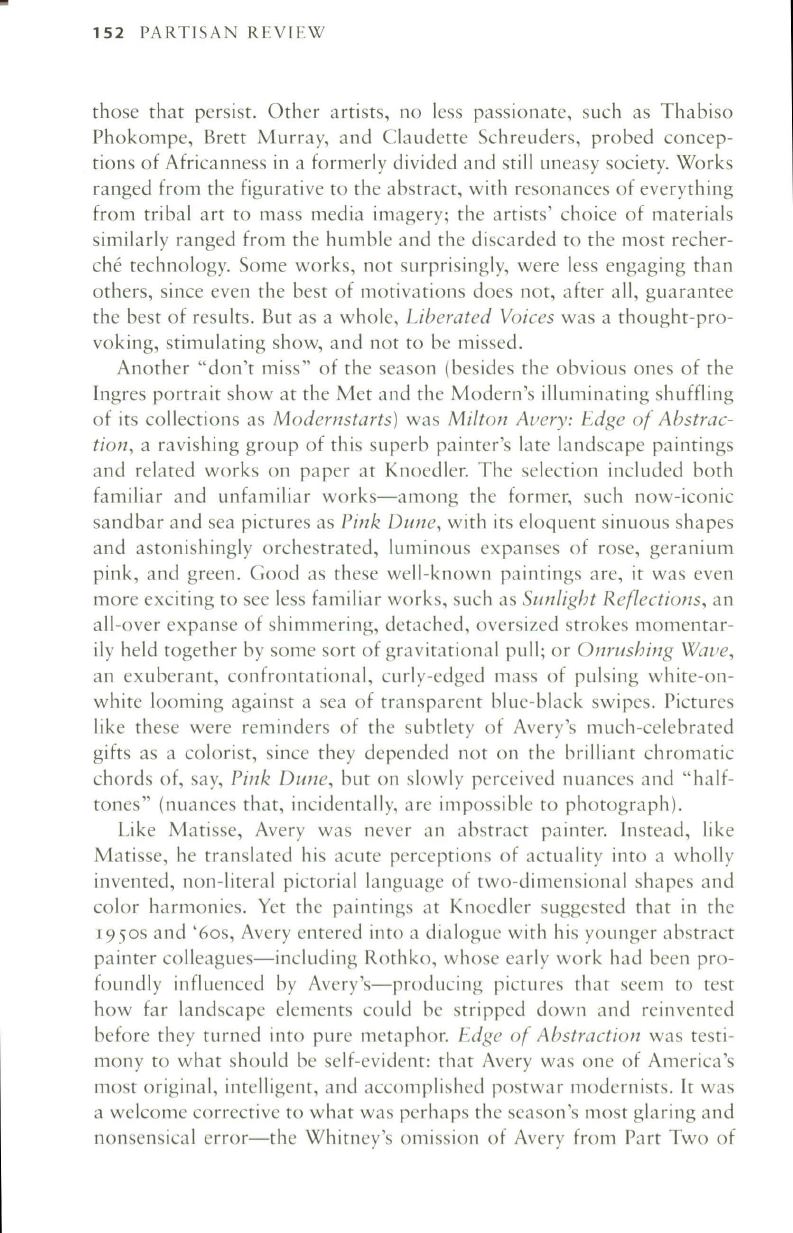
152
PARTISAN REVIEW
those that persist. Other artists, no less passionate, such as Thabiso
Phokompe, Brett Murray, and Claudette Schreuders, probed concep–
tions of Africanness in a formerly divided and still uneasy society. Works
ranged from the figurative to the abstract, with resonances of everything
from tribal art to mass media imagery; the artists' choice of materials
similarly ranged from the humble and the discarded to the most recher–
che technology. Some works, not surprisingly, were less engaging than
others, since even the best of motivations does not, after all, guarantee
the best of results. But as a whole,
Liberated Voices
was a thought-pro–
voking, stimu lating show, and not to be missed.
Another "don't miss" of the season (besides the obvious ones of the
Ingres portrait show at the Met and the Modern's illuminating shuffling
of its collections as
Modernstarts)
was
Milton Avery: Edge of Abstrac–
tion,
a ravishing group of this superb painter's late landscape paintings
and related works on paper at Knoedler. The selection included both
familiar and unfamiliar works-among the former, such now-iconic
sandbar and sea pictures as
Pink Dune,
with its eloquent sinuous shapes
and astonishingly orchestrated, luminous expanses of rose, geranium
pink, and green. Good as these well-known paintings are, it was even
more exciting to see less familiar works, such as
Sunlight Reflections,
an
all-over expanse of shimmering, detached, oversized strokes momentar–
ily held together by some sort of gravitational pull; or
Onrushing Wave,
an exuberant, confrontational, curly-edged mass of pulsing white-on–
white looming against a sea of transparent blue-black swipes. Pictures
like these were reminders of the subtlety of Avery'S much-celebrated
gifts as a colorist, since they depended not on the brilliant chromatic
chords of, say,
Pink Dune,
but on slowly perceived nuances and "half–
tones" (nuances that, incidentally, are impossible to photograph).
Like Matisse, Avery was never an abstract painter. Instead, like
Matisse, he translated his acute perceptions of actuality into a wholly
invented, non-literal pictorial language of two-dimensional shapes and
color harmonies. Yet the paintings at Knoedler suggested that in the
I9 50S
and
'60S,
Avery entered into a dialogue with his younger abstract
painter colleagues-including Rothko, whose early work had been pro–
foundly influenced by Avery's-producing pictures that seem to test
how far landscape elements could be stripped down and reinvented
before they turned into pure metaphor.
Edge of Abstraction
was testi–
mony to what should be self-evident: that Avery was one of America's
most original, intelligent, and accomplished postwar modernists. It was
a welcome corrective to what was perhaps the season's most glaring and
nonsensical error-the Whitney'S omission of Avery from Part Two of


